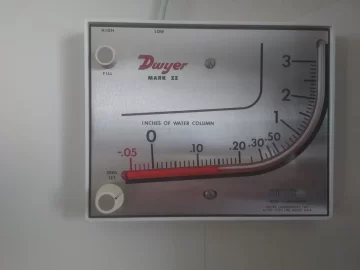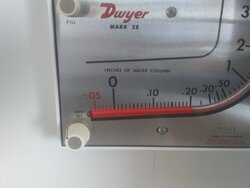I got my manometer today. Dwyer Mark II 25. Filled reservoir and zeroed out gauge. Installed it on wall and connected 10 inches of rubber tubing to 4 feet of 1/4 copper tubing. Connection is shrink wrapped since I have not located a 1/4 compression by 3/16 barb fitting yet. Stuck other end of copper tube into stove pipe about 9 inches above stove top. My stove top to chimney cap length is 14 feet straight up. ----I can drop this to 12 feet.
Today is quite windy. I do not have a fire going. At times the reading is .03 - .05. Then the wind get howling and I have seen the reading as high as .15.
Should I wait for a calmer day to be concerned about the readings?
Should I start a fire anyway and see what happens? (Or should I be on my way to the store to buy a damper?)
I saw FixedGearFlyer's video with his Magnehelic that displays .06 with his furnace running.
I expect more draft with fire burning.
SBI states that I should look for .03 - .05. A reading of .08 would be excessive draft.

Today is quite windy. I do not have a fire going. At times the reading is .03 - .05. Then the wind get howling and I have seen the reading as high as .15.
Should I wait for a calmer day to be concerned about the readings?
Should I start a fire anyway and see what happens? (Or should I be on my way to the store to buy a damper?)
I saw FixedGearFlyer's video with his Magnehelic that displays .06 with his furnace running.
I expect more draft with fire burning.
SBI states that I should look for .03 - .05. A reading of .08 would be excessive draft.



